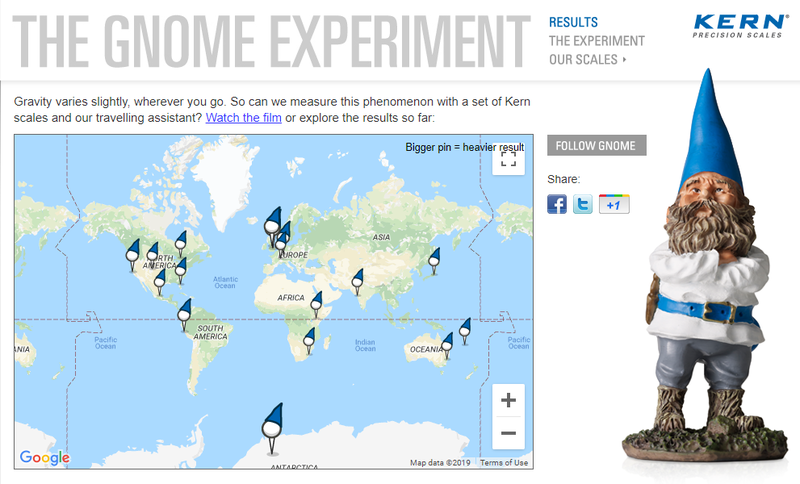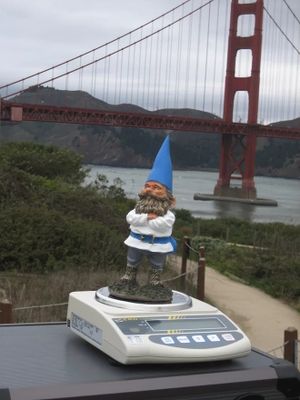Difference between revisions of "Weight Variation by Latitude"
Tom Bishop (talk | contribs) |
Tom Bishop (talk | contribs) |
||
| Line 22: | Line 22: | ||
If the air pressure from the calibration environment is different than the operating environment, it will effect the scale. Also listed on the page are temperature and humidity which can affect the operation of a precision scale. | If the air pressure from the calibration environment is different than the operating environment, it will effect the scale. Also listed on the page are temperature and humidity which can affect the operation of a precision scale. | ||
| + | |||
| + | ==Kern Gnome Experiment== | ||
| + | |||
| + | The precision scale manufacturer Kern conducted a public test of the variation of weight by latitude, showing that weight changed when a ceramic gnome and one of its precision scale were sent to members of the public at different latitudes: | ||
| + | |||
| + | Website: http://gnome-experiment.com/ | ||
| + | |||
| + | [[File:Kern Experiment.png|800px]] | ||
| + | |||
| + | ===Scale Not Calibrated=== | ||
| + | |||
| + | The scale was calibrated in Germany and sent to different areas: | ||
| + | |||
| + | https://www.chemistryworld.com/news/gnomadic-experiment/4924.article | ||
| + | |||
| + | {{cite|Kern the gnome and a Kern and Sohn balance, '''calibrated at the firm’s laboratory in Balingen, Germany,''' are travelling around the world to anyone who requests a visit in a specially designed flight case. Gloves and cleaning implements also come along for the ride, so the mass of the gnome isn’t altered by dirt or over enthusiastic cleaning. | ||
| + | |||
| + | Several factors affect the gravitational field at different locations on the Earth, for example the closer Kern gets to the equator, the less he should weigh because the velocity of the Earth’s spin at the equator (1670km/hr) counteracts the force of gravity by up to 0.3%. This weight loss will also be increased by the equatorial bulge that means Kern would be further from the centre of our planet and gravity is proportional to the inverse square of the distance between two objects.}} | ||
| + | |||
| + | [https://www.dailymail.co.uk/sciencetech/article-2117738/Long-weigh-gnome-The-bizarre-experiment-garden-ornament-travels-world-measure-gravity.html Long weigh from gnome: The bizarre experiment where a garden ornament travels the world to measure gravity] | ||
| + | |||
| + | {{cite|Kern travels in a reinforced case containing himself and a '''Kern EWB 2.4 Scale calibrated according to local gravity in Balingen, Germany''', to ensure any weight change he encounters on his travels shows up.}} | ||
| + | |||
| + | ===Procedure=== | ||
| + | |||
| + | Members of the public were instructed to place the gnome onto the scale and to report their results: | ||
| + | |||
| + | [[File:Gnome-sf.jpg|300px]] | ||
Revision as of 21:32, 27 June 2019
Weight Variation by Latitude refers to the claims that scales have measured masses to be slightly more or less at different points on earth. It is asserted that, due to a combination of the centrifugal effect and the further distance from the center of mass, bodies will weigh less at the equator than the poles.
Upon assessment of the experiments supporting this, it is found that these experiments are conducted with the scale and body exposed to the surrounding atmosphere. A scale is calibrated for one area and then taken to another area, uncalibrated. Measures are not taken to isolate the test body and the measuring device from the influences of the environmental atmosphere. It is known that pressure and humidity affects scales. It is also known that that pressure is greater at the poles and lesser at the equator. It is further known that pressure is greater at lower altitudes near sea level and lesser at higher altitudes—the same general relationship the weight changes are said to occur. Humidity likewise has a relationship with between altitudes and latitudes.
Andrew Huszczuk, Ph.D. writes:
“ Would you take a medication knowing that a pharmacy used an uncalibrated scale to weigh its ingredients? Would you board a plane knowing that the fuel or altitude gauges are not calibrated at frequent intervals?
In these and thousands of other applications scientific bases and rules of metrology must be obeyed to assure chaos-free operation of modern societies. To scrutinize performance of measuring devices a process of calibration must be carried out by means of applying a known standard and getting back a correct reading. ”
Scales Affected by Atmosphere
From Drift in Measurements with Analytical Balances we read:
“ Pharmaceutical laboratories and bioscience research institutes make extensive use of analytical balances that are highly sensitive. These analytical balances are greatly affected by their environment and also by the way they are installed and handled. ”
One precision scale manufacture lists many factors which can affect a scale:
Factors That Can Affect Your Scale’s Accuracy
“ Differences in air pressure – Scales can provide inaccurate measurements if the air pressure from the calibration environment is different than the operating environment. ”
If the air pressure from the calibration environment is different than the operating environment, it will effect the scale. Also listed on the page are temperature and humidity which can affect the operation of a precision scale.
Kern Gnome Experiment
The precision scale manufacturer Kern conducted a public test of the variation of weight by latitude, showing that weight changed when a ceramic gnome and one of its precision scale were sent to members of the public at different latitudes:
Website: http://gnome-experiment.com/
Scale Not Calibrated
The scale was calibrated in Germany and sent to different areas:
https://www.chemistryworld.com/news/gnomadic-experiment/4924.article
“ Kern the gnome and a Kern and Sohn balance, calibrated at the firm’s laboratory in Balingen, Germany, are travelling around the world to anyone who requests a visit in a specially designed flight case. Gloves and cleaning implements also come along for the ride, so the mass of the gnome isn’t altered by dirt or over enthusiastic cleaning.
Several factors affect the gravitational field at different locations on the Earth, for example the closer Kern gets to the equator, the less he should weigh because the velocity of the Earth’s spin at the equator (1670km/hr) counteracts the force of gravity by up to 0.3%. This weight loss will also be increased by the equatorial bulge that means Kern would be further from the centre of our planet and gravity is proportional to the inverse square of the distance between two objects. ”
“ Kern travels in a reinforced case containing himself and a Kern EWB 2.4 Scale calibrated according to local gravity in Balingen, Germany, to ensure any weight change he encounters on his travels shows up. ”
Procedure
Members of the public were instructed to place the gnome onto the scale and to report their results:


